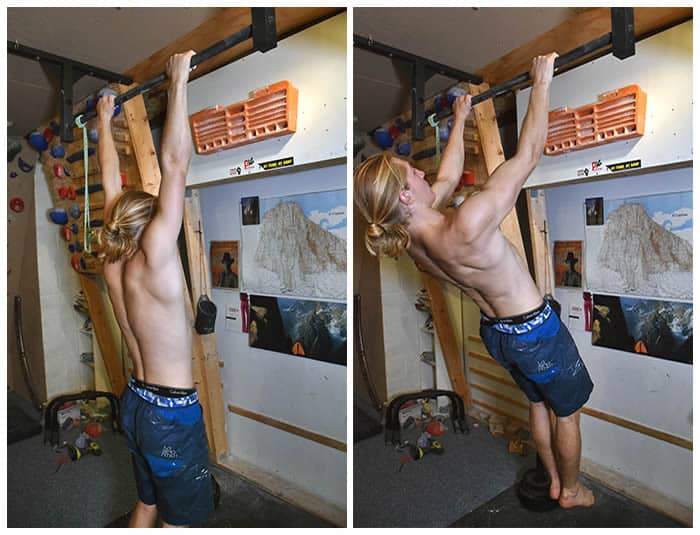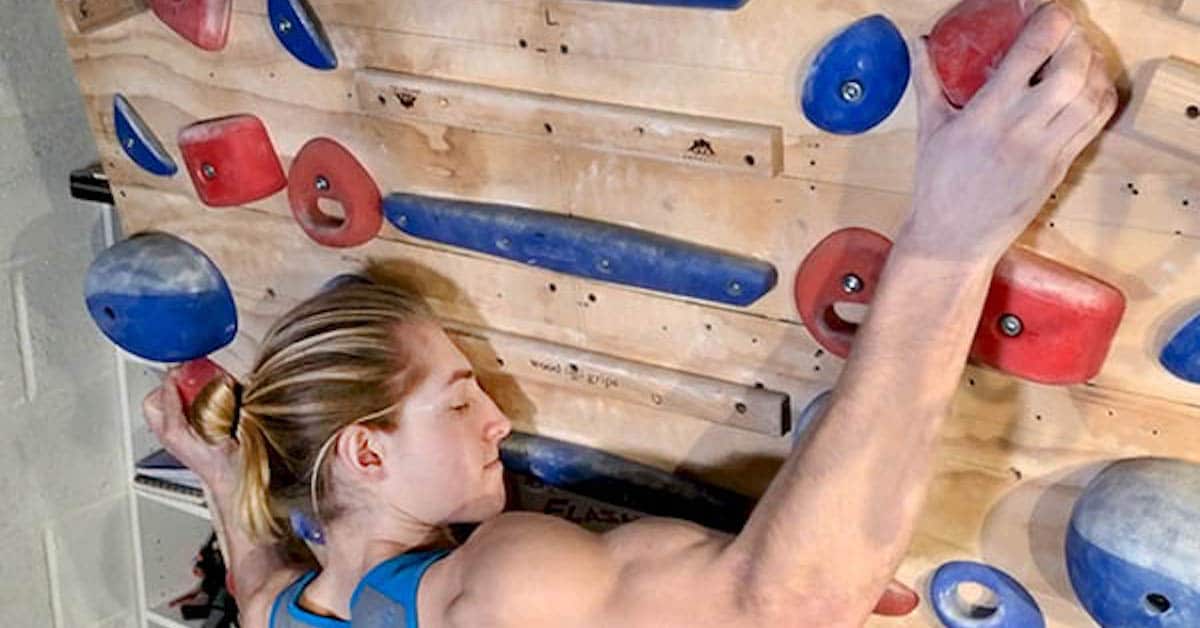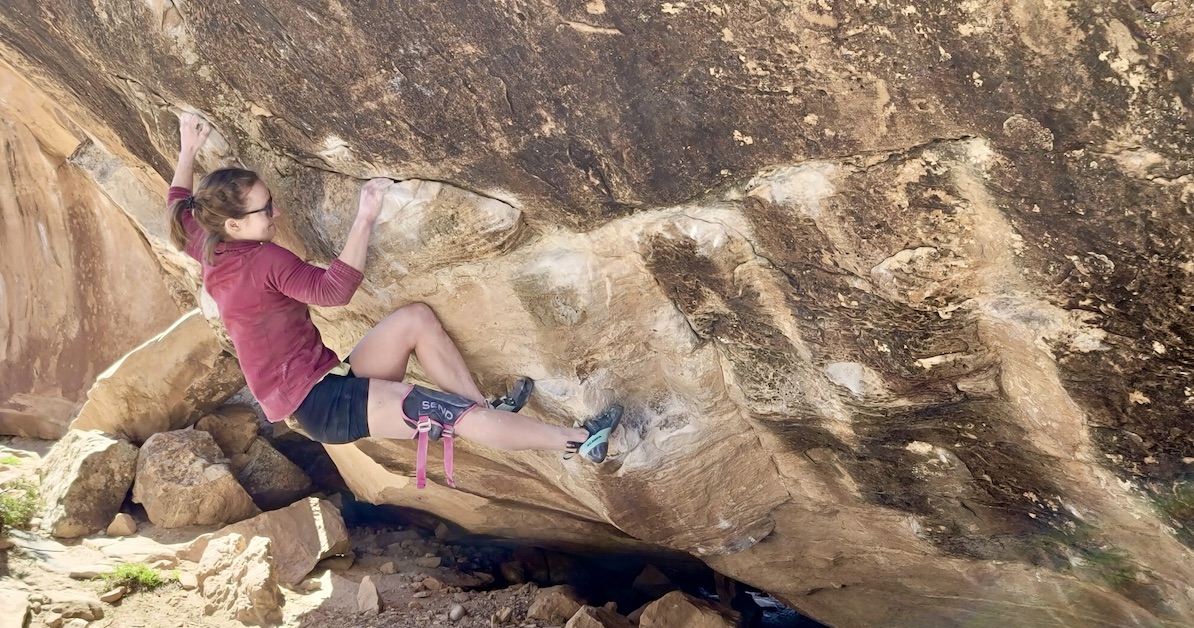Learn how to develop stronger, more injury-proof shoulders with the scapular pull-up, a variation on the classic pull-up that isolates the lower trapezius and latissimus muscles.
(This article was originally published in September of 2020, but the Scapular Pull-Up has the same impact today!)
The scapular pull-up is a training essential in the Hörst family gym! That’s because keeping your shoulders healthy is key to strong sustainable climbing. Developing shoulder strength and proper movement patterns in pulling motions demands the ability to forcefully depress, rotate, and retract the scapula. Regular use of this isolation exercise will lead to better kinesthetic awareness of your scapula position. Not only that, the strength you can will enable you to climb harder and longer with good form in the face of accumulating fatigue. The ability to quickly and forcibly engage the lower trapezius and latissimus muscles that bear the brunt of this exercise will train you to align your scapula during campus training and lunging for big moves.
How To Do the Scapular Pull-up
- Begin in a typical pull-up position with palms facing away and hands shoulder-width apart.
- From a full-hang position, draw your scapula down and together. Think of raising your body slightly without bending your arms as you would for a regular pull-up. Try to “bend the bar” and mimic a reverse shrug (i.e. shoulders drawn downward). You’ll feel your head shift backward and your chest raise upward as your scapular pinch together.
- Hold the top position for one second, then return to the starting position. The range of motion is only a few inches.
- Perform six to twelve reps, keeping nearly straight arms and tight spinal erectors and glutes throughout. At first, you may find this to be a difficult exercise (a sign that you’ve identified a critical weakness!) but resist the urge to overdo it.
- Do two sets with a three minute rest in between.
- Add a third set to your workout only after you’ve mastered the exercise. A good long-term goal is to do three sets of ten reps.

1. Begin from a low pull-up position with passive shoulders. 2. Maintaining straight arms, depress and downwardly rotator your scapula—think about trying bend the bar as you pull your shoulders down and press your chest out.
Training Tip: Strong climbers will do this exercise with full body weight, but I suggest decreasing the resistance while you’re learning by keeping your feet on the floor (or elevated on a chair) and flexing your knees enough to hang with straight arms from a pull-up bar.
Advanced Scapular Pull-up
If you’re a more experienced climber, with strong shoulders and pulling muscles, then the Advanced Scapular Pull-up is for you!
Begin the same way as the regular Scapular Pull-Up, but bring yourself higher and farther back as if you’re trying to pull into a Front Lever. Your arms will bend just a bit, but strive to keep them as straight as possible. Use the cues “bend the bar” and “press the bar away” to guide your movement. Maintain engaged glutes and extended legs throughout the range of motion. Build towards doing three sets of ten.

1. Begin from an ordinary pull-up start position. 2. Maintaining nearly straight arms, depress and downwardly rotator your scapula by pressing down on the bar. Think about trying bend the bar (supinating your forearms) as you press your chest out and raise your hips…as if beginning a Front Lever.
PRO TIP: Nourish Your Tendons and Joints Before Each Climbing Workout!
A growing body of research has demonstrated the benefits of a specific pre-exercise nutritional protocol designed to amplify collagen synthesis and soft tissue recovery. Consuming vitamin C-enriched hydrolyzed collagen before rigorous training is the lynchpin of the protocol shown to support connective tissue remodeling and recovery from powerful workouts.
Related Articles:
- Video: The Best Climbing Exercise You’re Not Doing!
- My Favorite Core Exercise: Windshield Wipers
- Training with Long Duration Isometric Exercises
- At-Home Exercises for Climbers
- Two Basic Exercises for Developing Strength and Power for Climbing
Copyright © 2000–2023 Eric J. Hörst | All Rights Reserved.








![🚨New Training For Climbing podcast drop! [**Link in bio.**]
This a two-part deep dive into designing a comprehensive, long-term systems approach to training. Coach @eric_horst unpacks—in rich detail—how systems actually function, and he highlights how transformative climbers throughout history “shake up the box” with innovative, highly effective methods to achieve big goals and push the boundaries of our sport.
In Part 1 (#122), Eric blends a concise climbing history lesson with an engineer-like breakdown of how intelligent systems operate. Part 2 (#123) of this series will deliver the actionable strategies you can use to build a personalized, high-performance training system for this winter…and for many seasons to come.
Eric emphasizes that as climbers progress beyond the beginner stage, climbing and training grow increasingly complex—requiring intentional, organized, and year-round development of strength, technique, mental skills, recovery habits, nutrition, and lifestyle management. Rather than ad-lib sessions or singular-focus programs (like only training strength), climbers need a comprehensive system fine-tuned daily and seasonally.
This is an entertaining and thought-provoking episode—so lean in, listen closely, and get ready to feel inspired, challenged, and equipped to level-up your modus operandi at the crag, in the gym, at home, and in everything you do! Listen on Apple Podcasts, Spotify, or online using the web player below.
#climbingtraining #bouldering #indoorclimbing #climbing #climbingpodcast #erichorst #trainingforclimbing @lasportivana @physivantage](https://trainingforclimbing.com/wp-content/plugins/instagram-feed/img/placeholder.png)


